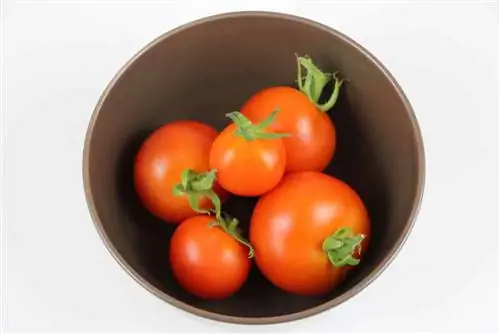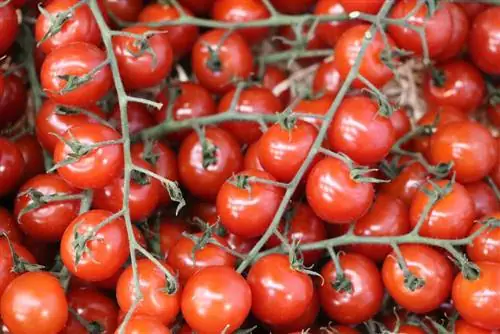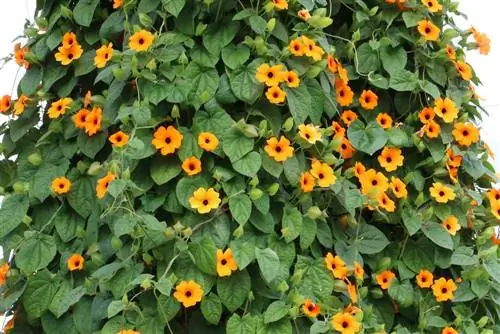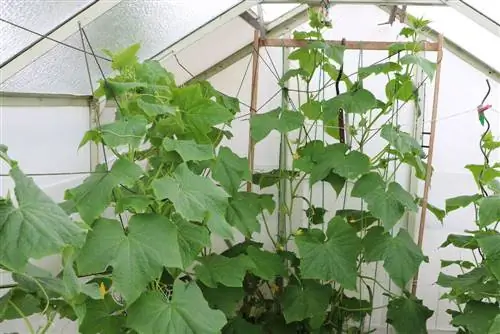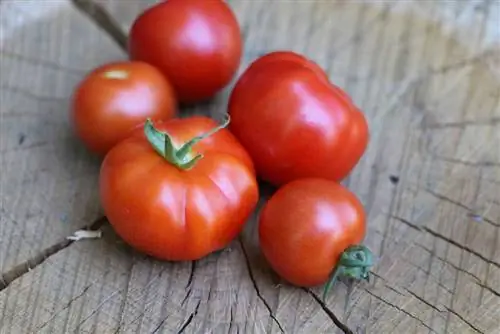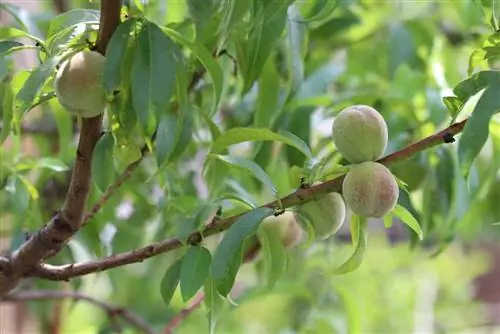- Author admin [email protected].
- Public 2023-12-17 03:39.
- Last modified 2025-01-24 12:45.
Most vine tomatoes reach a maximum height of 50 centimeters. So they grow more in width than in height, which is why you should ensure a generous planting distance. A planting distance of 80 centimeters is optimal for the development of plants outdoors. Next vine tomatoes need:
Location
- a sunny and bright location
- at least eight hours of sun every day
- a sheltered location that is also airy
If vine tomatoes are grown in a bucket on the balcony, a south-facing balcony is ideal for the plants. But they also thrive on an east or west balcony.
Floor
Vine tomatoes are heavy feeders, which is why they need extremely nutrient-rich soil. There is special tomato soil for pot cultivation that is optimally tailored to the needs of the plants. The soil should also have the following properties:
- well drained
- easy
- calcareous
- slightly acidic (pH value: 6.5 to 7.0)
Tip:
Whether the soil in the garden is suitable for cultivation can be easily checked using the so-called snowball trick. Form a snowball out of the garden soil. The earth is suitable if the snowball keeps falling apart.
Plants
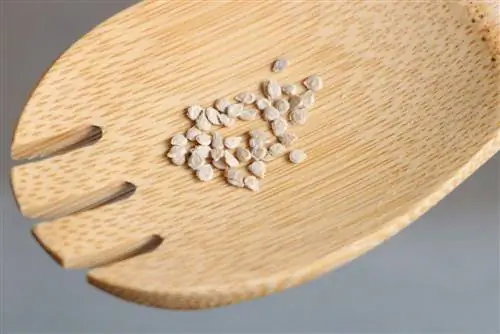
Vine tomatoes can be grown from seeds. It is best to sow the seeds from early to mid-March and place them in a container on the windowsill. Special growing trays or small pots made of peat or cellulose are suitable as containers. If you want to grow a lot of vine tomatoes, you can also use so-called multi-pot plates for cultivation. A nutrient-poor potting soil is ideal for the seeds. When sowing the seeds, proceed as follows:
- Pour potting soil loosely into the containers
- Spread seeds around three centimeters apart
- cover lightly with substrate
- water very carefully
- Cover planter
- do not close completely
- ventilate daily
- Keep growing soil evenly moist
- choose a bright location
- Temperature between 20 and 24 degrees Celsius
The seedlings should emerge from the soil after about ten to fourteen days. The first leaves can then be seen after one to two weeks. Now they can be picked and placed in a planter.
Tip:
In order to strengthen the young vine tomatoes, the seedlings should be given liquid fertilizer a few days before planting. The plants should be watered two to three hours before moving.
If the seedlings have been prepared accordingly, they can be transplanted. Proceed as follows:
- Loose up the potting soil with a stick or spoon
- Carefully remove the seedling from the container
- free from the earth
- Short roots to two centimeters
- Put plants in new planter
- fill with soil
- Press the soil gently
- pour carefully
Before you move the plants, you should check the root system. For further cultivation, only use vine tomatoes that have long, white and strong roots. If the roots are brown or very thin, the plant should be discarded because it will not develop well or will bear no or very few fruits.
Hardening
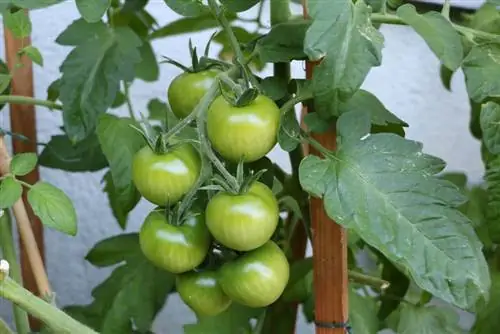
Since the very young vine tomatoes are very weak and vulnerable, they remain in the protected interior for the first few days after being moved. In addition, the plants should only be placed on the windowsill after a few days. This allows the young plants to slowly get used to the sun. Since cooler days can occasionally occur in our latitudes, even in summer, the plants must be hardened off slowly and carefully. To do this, initially only put the plants outside for a few hours from the end of April or the beginning of May. You should also note the following when hardening:
- Outside temperature of at least eight degrees Celsius
- Night temperature not below ten degrees Celsius
- choose a partially shaded location
- no direct midday sun (risk of sunburn)
- protect from wind and rain
If the rain and wind are too heavy, the plants should be brought back inside. Alternatively, they can be protected with a rain cover, such as a special tomato cover.
Planting
The outdoor season for vine tomatoes begins in mid-May after the Ice Saints, when night frosts are no longer expected. This is also the optimal time to put your home-grown or pre-grown plants in the garden bed or in the pot.
Tip:
If vine tomatoes are grown in a bucket, a drainage layer should be created. To do this, for example, put potsherds in the bottom layer of the planter.
Trails
Since vine tomatoes reach a maximum height of 50 centimeters, a trellis in the traditional sense is not absolutely necessary.
However, it is still advisable to support the plants so that they do not fall over in strong winds. The following are suitable as supports:
- short tomato sticks made of plastic, wood, bamboo or metal
- small trellises, pyramids or obelisks
Tip:
If the vine tomatoes are grown in a hanging basket, there is no need for a climbing aid.
Bucket Culture
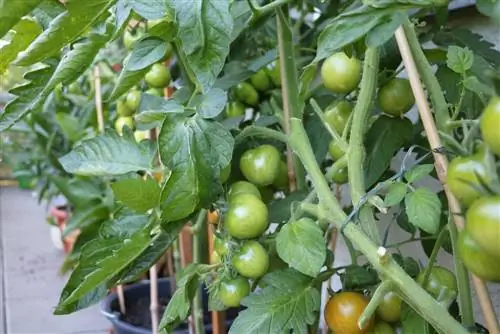
Vine tomatoes are more often grown in containers than in garden beds. To ensure that the plants bear plenty of fruit, they should be planted in a planter made of wood, clay, Eternit or plastic.
Tip: Make sure that the planter has drainage holes, because vine tomatoes cannot tolerate waterlogging.
Although the size of the planter depends on the respective variety, you should always consider the following when choosing:
- Pot size between three and ten liters
- Minimum diameter for a plant: 20 centimeters
- Roots need a lot of space
- ev. Planter with water storage with a water level indicator
Tip:
If in doubt, choose a planter that is too large instead of too small.
Care
In order for the harvest to be plentiful, vine tomatoes need good and regular care. The most important care measures are watering and fertilizing. The delicious fruits can only be harvested if the substrate is kept moist and the plants are supplied with sufficient nutrients.
Tip:
Remove any flowers that form from mid-August onwards. This is how the power of the plant flows into the already existing fruits.
Pouring
Vine tomatoes must be kept constantly moist. That's why you should water the plants several times a day in summer, depending on the weather. Ideally, vine tomatoes receive rainwater. Alternatively, they are watered with stale, lukewarm tap water. It's best to always water the plants from below so that the leaves don't get wet. The optimal time for watering is in the morning. Additional watering can occur in the afternoon or early evening. When watering, make sure that no waterlogging occurs, as the plants cannot tolerate that.
Tip:
Since vine tomatoes need a lot of water, planters with an integrated water reservoir are recommended. This means that the plants are optimally supplied with water, especially on very hot days.
Fertilize
As heavy eaters, vine tomatoes constantly need nutrients. That's why they need to be fertilized regularly. If the plants are cultivated in the garden bed, compost or livestock manure are ideal fertilizers. Liquid fertilizer, fertilizer sticks or drops can be administered for pot culture. If no long-term fertilizer is used, it is best to provide the vine tomatoes with fertilizer every two to three weeks until fruit sets. The plants are then fertilized once a week.
Tip:
Tree tomatoes also enjoy additional gifts such as coffee grounds or nettle broth.
Simply
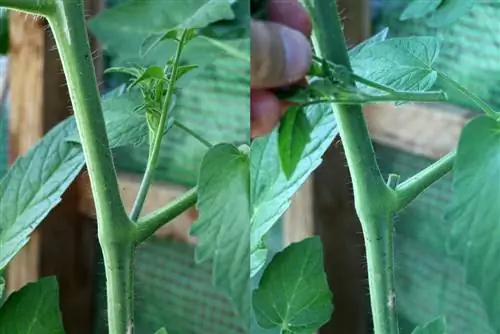
Vine tomatoes do not have to be displayed. Because with these varieties, bushy, multi-shoot growth is desirable.
Toxicity
Vine tomatoes belong to the nightshade family. Only the fruits, i.e. tomatoes, are suitable for consumption. The green parts of the plant are poisonous and can cause vomiting diarrhea, nausea or headaches. The tomato flowers are also not suitable for consumption. Tomatoes that are infested with pests should also not be eaten, as the plant produces increased toxins as a defense mechanism.
Wintering
Although vine tomatoes are not hardy, they can be overwintered if they are grown in a container. In order for the plants to survive the German winter, they have to move to winter quarters. Ideal conditions are:
- a bright location
- a maximum temperature of 15 degrees Celsius
- The following applies to care:
- do not fertilize
- Keep substrate moist
Harvest
Although vine tomatoes have the advantage that they don't grow very tall, the small disadvantage is that the harvest is slightly lower than with stick tomatoes. The ideal time to harvest is when the tomatoes have turned yellow or red, depending on the variety. Then they can be easily removed from the plant. They are usually harvested with the calyx and stems. If they are not consumed immediately, they can be stored at a temperature of 16 to 18 degrees.
Tip:
Storing in the refrigerator is not recommended as the temperature in the refrigerator is too cold.
Propagate
Vine tomatoes can be propagated with cuttings. Since no suitable shoots are produced by thinning out, a side shoot must be used for propagation. It is best to use a side shoot above the first branch for propagation. After cutting off the shoot, proceed as follows:
- Remove up to two thirds of the leaves from the cutting
- Plant cuttings quickly
- Vegetable soil is ideal
- water generously without wetting the shoot
- Tie the cutting to a small wooden stick as a support
- choose a partially shaded location
If the growing container is well rooted, you can transfer the cuttings to a planter or garden bed.
Varieties
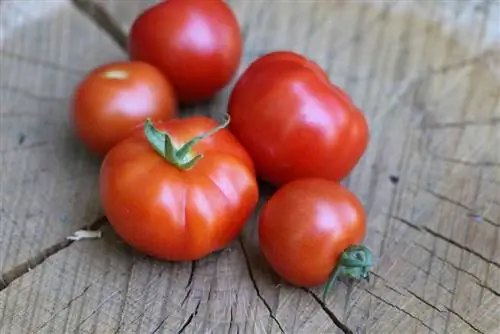
Tube tomatoes, also known as bush tomatoes, are small tomato plants. Like the so-called stick tomatoes, they belong to the nightshade family (Solanaceae). There are different varieties of vine tomatoes. The most popular include:
- Losetto
- Balconi Red
- Maglia Rosa
- Little Red Riding Hood
These varieties reach a height of between 30 and 50 centimeters.
Diseases and pests
Tomato diseases are caused by care errors, unfavorable weather or by infection. The most common fungal diseases include:
- drought spot disease
- Blight and brown rot
- Powdery mildew
- Gray horse
If a fungal infestation has been noticed, all affected parts of the plant must be removed immediately and ideally disposed of with household waste. If the vine tomatoes are cultivated in a bucket, infected plants should be isolated. Preventive measures include a bright location and watering “from below” so that the leaves do not become damp.
Among the animal pests, the whitefly is particularly dangerous for plants.

